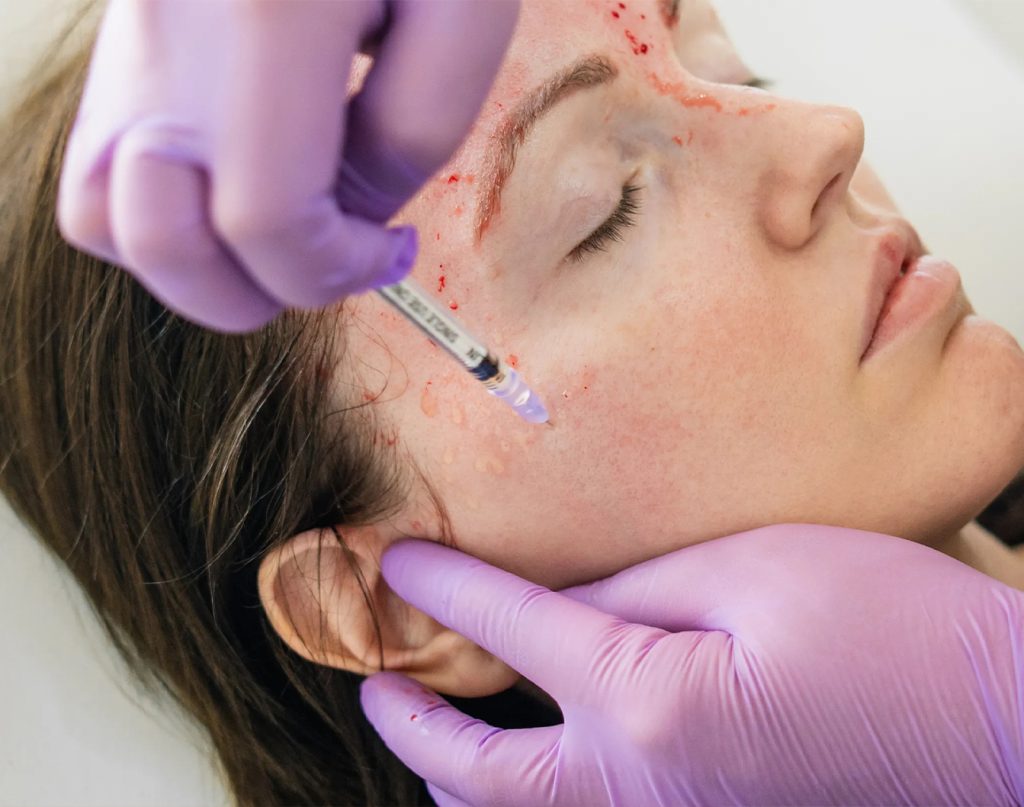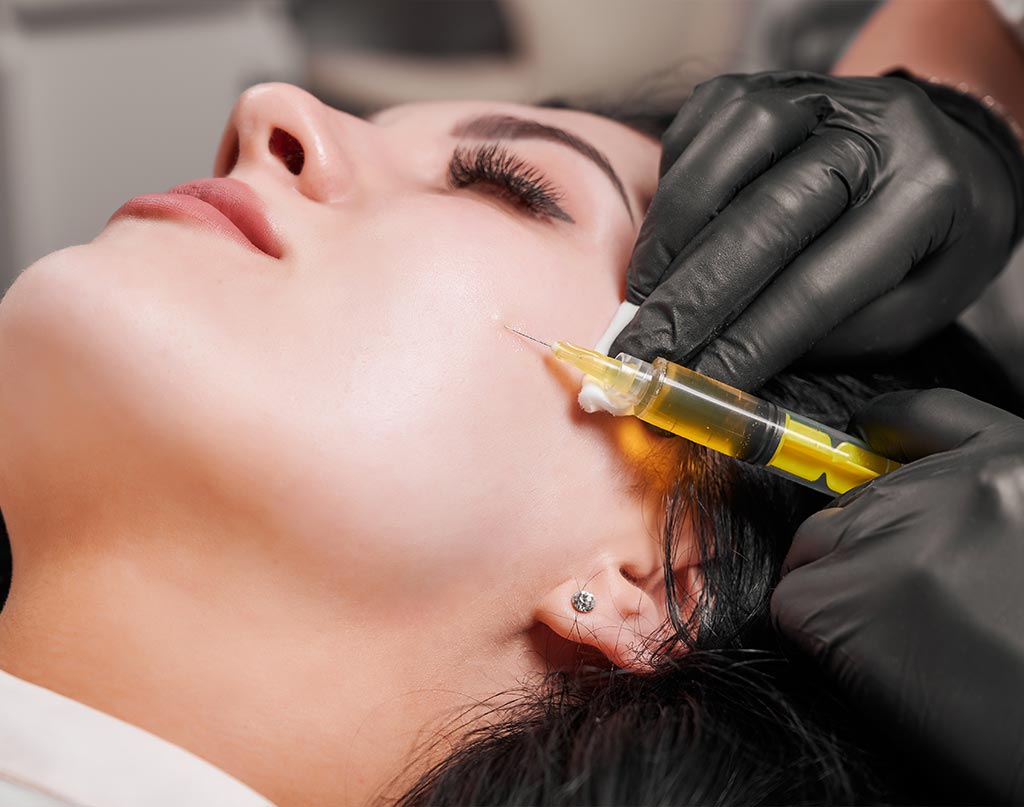CLINICAL TREATMENTS
PRP/Platelet Rich Plasma
What is PRP?
Healing. Stimulating. Collagen inducing.
Platelet-Rich Plasma PRP has become a highly sought-after non-surgical procedure for facial and skin rejuvenation. PRP therapy is a treatment which uses your own blood platelets to stimulate new cell growth, helping to improve your complexion, skin texture and to restore lost facial volume.


What is PRP?
Healing. Stimulating. Collagen inducing.
Platelet-Rich Plasma PRP has become a highly sought-after non-surgical procedure for facial and skin rejuvenation. PRP therapy is a treatment which uses your own blood platelets to stimulate new cell growth, helping to improve your complexion, skin texture and to restore lost facial volume.
What is this treatment for?
PRP is used to treat signs of aging such as dull skin tone, fine wrinkles, tough wrinkles, thinning hair and hair loss!
The History of PRP:
PRP has a long history of being used in orthopaedic medicine, dentistry, and reconstructive surgery, and now its benefits are being applied to other fields of medicine such as dermatology, skin wound healing, and cosmetic facial rejuvenation. Scientific studies dating back 30 years have documented that PRP grows new collagen when injected into the skin, and newer studies show that PRP can soften sun damage and aging skin issues.
What is involved in the procedure?
A small amount of blood (20cc‐55cc) is drawn up from your arm into a syringe. The blood is spun down in a special centrifuge to separate its components (Red Blood Cells, Platelet Rich Plasma, and Plasma). After the platelet rich plasma is separated, it is then activated with a small amount of calcium to allow the release of growth factors from the platelets which in turn amplifies the healing process. PRP is then injected into the area to be treated.

How does PRP therapy differ from other injections or fillers?
Hyaluronic acid fillers, such as Restylane and Juvederm , are composed of solid material that fills lines and skin folds. These fillers are indicated to soften deeper lines such as the folds around the mouth area, or to plump lips. They usually last from 6-18 months; repeated treatments are required to fill the area again.
PRP stimulates your own collagen to grow for total facial rejuvenation rather than individual wrinkle improvement. PRP is used for volumizing faces that are beginning to look drawn, to plump out cheek indentations, soften under eye hollows , improve the skin tone, tightness, and texture, and fill in areas where hyaluronic acid fillers cannot reach or are not safe to use.
What are platelets and why do we want them?
Platelets are very small cells in your blood that are involved in the clotting process. When PRP is injected into the damaged area it causes a mild inflammation that triggers the healing cascade. As the platelets organize in the clot they release a number of enzymes to promote healing and tissue responses including attracting stem cells to repair the damaged area. As a result new collagen begins to develop. As the collagen matures it begins to shrink causing the tightening and strengthening of the damaged area. When treating injured or sun and time damaged tissue they can induce a remodeling of the tissue to a healthier and younger state.
How long does the procedure take?
The full procedure takes approximately 45 minutes ‐ 1 hr.
What are the benefits of PRP?
Along with the benefit of using your own tissue (therefore eliminating allergies) there is the added intrigue of mobilizing your own stem cells for your benefit. PRP has been shown to have overall rejuvenating effects on the skin as in: improving skin texture, fine lines and wrinkles, increasing volume via the increased production of collagen and elastin, and by diminishing and improving the appearance of scars.
Other benefits: minimal down time, safe with minimal risk, short recovery time, natural looking results, no general anesthesia is required.
What is the goal of treatment?
The goal of PRP skin rejuvenation therapy is to improve skin tone and texture, tighten skin, soften lines and pores. Results begin to show 3-4 weeks after the treatment session and continue to improve with time. Three treatment sessions are generally recommended, spaced 1-2 months apart, to achieve the best outcome.
Allure Medical Aesthetics
Where quality meets satisfaction every time. Join us and elevate your journey to new heights!
Are there any reasons why I can’t have PRP therapy?
Like the majority of cosmetic procedures, ladies who are pregnant, breast-feeding or trying to conceive are not suitable candidates. This treatment is not recommended in people on anti-coagulation treatment, autoimmune conditions, have suffered any type of cancer or who have certain implants in the treatment area. Your past and present medical history, as well as your past cosmetic history will be assessed to determine your suitability.
What are the risks and complications of PRP?
Some of the Side Effects of Platelet Rich Plasma include:
1) Pain or itching at the injection site
2) Bleeding, Bruising, Swelling and/or Infection
3) Short lasting pinkness/redness (flushing) of the skin
4) Allergic reaction to the solution
5) Injury to a nerve and/or muscle
6) Nausea/Vomiting
7) Dizziness or fainting
8) Temporary blood sugar increase.
When will I see results and how long do they last?
When will I see results and how long do they last? Results are generally visible at 3 weeks and continue to improve gradually over the next 3‐6 months with improvement in texture and tone. Advanced wrinkling cannot be reversed and only a minimal improvement is predictable in persons with drug, alcohol, and tobacco usage. Severe scarring may not respond. Current data shows results may last 18‐24 months. Of course all individuals are different so there will be variations from one person to the next.
Schedule your appointment today with Lynda Quesnel NP for a free consultation and skin evaluation. She will determine the treatment options best suited for you!
